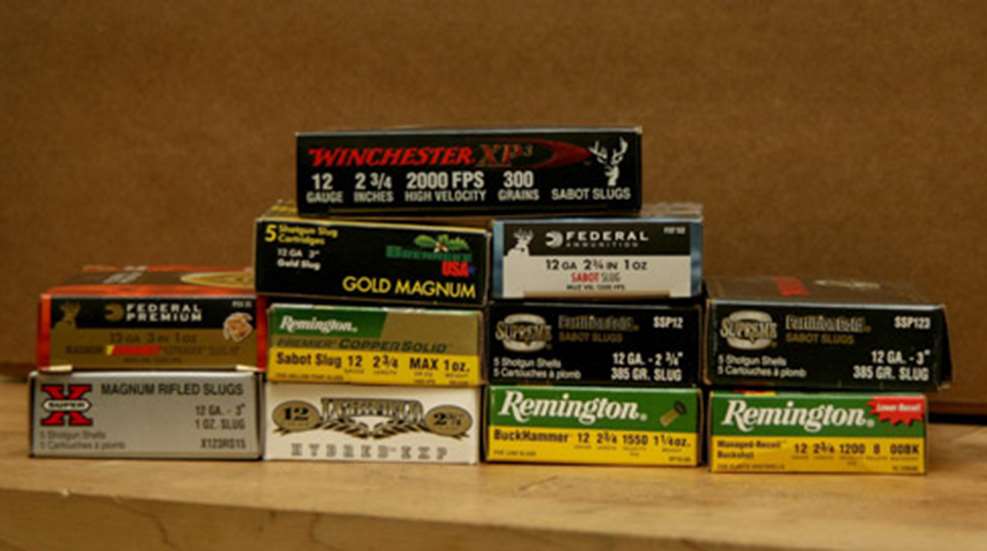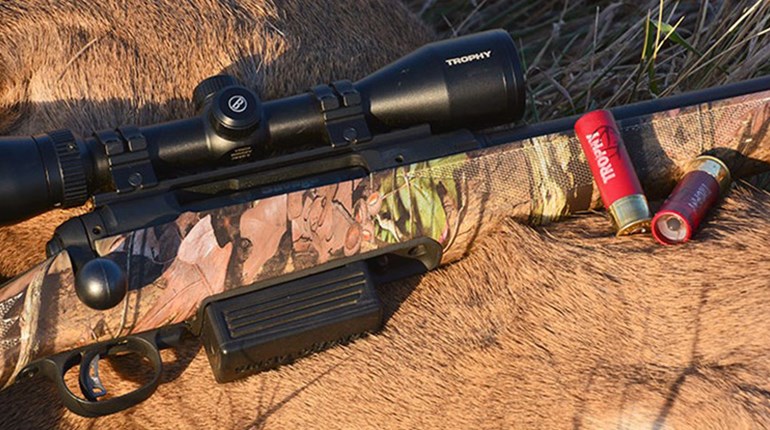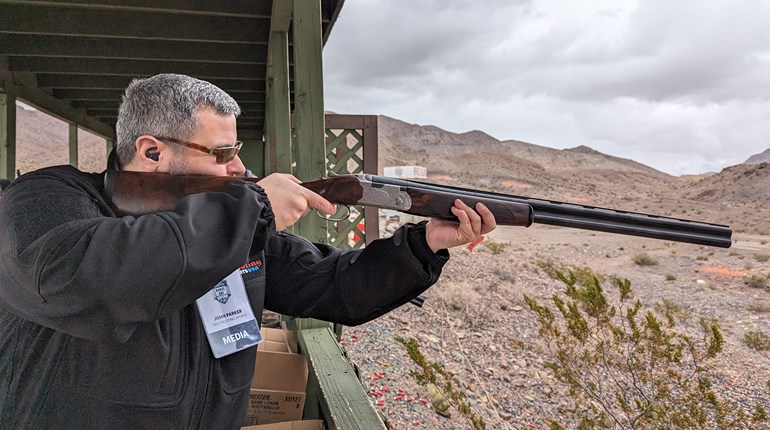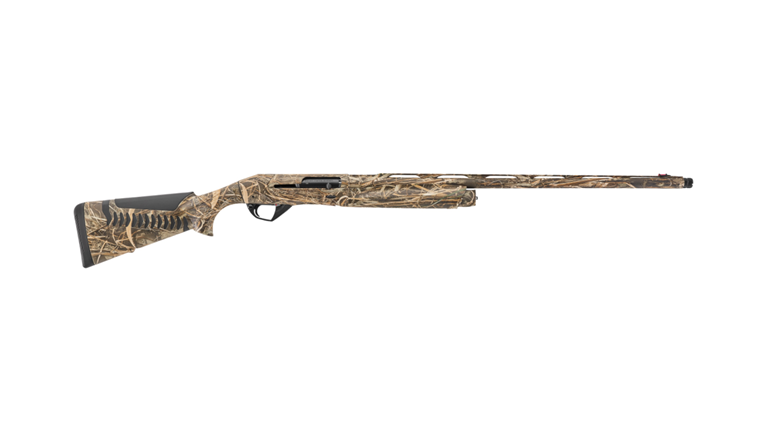
I’ve always been a fan of slug guns. Perhaps because I was brought up in a slug-only state. On the farm, a shotgun was an essential tool. When I was growing up, my father had one shotgun he used for everything. A Browning Auto-5 served as his upland game gun, and the week after Thanksgiving the same gun became his deer gun. Contrary to rational thinking, the smooth bore 26-inch vent rib barrel shot a 1 ounce pumpkin ball with uncanny accuracy—a 3-inch group at 100 yards. Dad preferred the vent rib and the two beads as the sighting method; although deer barrels were available, the ransom for one proved too much for Dad’s blood.
Most hunters have a selection of shotguns, each specifically suited for every season. Deer season finds a hunter with a scope mounted fully rifled designated slug gun; for turkey season, a short barreled 3 ½-inch pump or semi-auto with an extra full choke is chosen. For upland game, a small gauge over-under or side by side, and for waterfowl yet another semi-auto wrapped in Mossy Oak DuckBlind or similar camo pattern.
What about the one-shotgun hunter? Is he doomed when it comes to shooting a slug gun? No way! Today, there are several options to turn most any shotgun into a slug gun without spending the kind of cash it takes to buy a new one.
A New Barrel
The interchangeability of barrels has been quite a boon to shotgun hunters. A shotgun-wielding hunter can install a barrel to duck hunt one day and switch to a short barrel equipped with rifled sights for deer season. Slug barrels come in either rifled or smooth models. Many smooth bore models come with a choke system installed in the barrel. Some barrels have a cantilever system attached to the barrel that permits the mounting of a scope onto the barrel. In theory, the scope moves with the axis of the bore.
I recently picked up a slug barrel for my now “out of production” Winchester 1300 on GunBroker for a fraction of the price of a new shotgun.
Rifled Chokes
Rifled chokes aren’t anything new, but to many shooters they are often overlooked as a viable option for slug gun hunters. However, not all choke tubes are created equal.
I prefer chokes that use cut rifling, though most any type of rifling performs better than a smooth choke. If you are old school, consider a modified or improved cylinder for the choke that handles a slug the best.
Auxiliary Sights
Auxiliary sights mount to the barrel and can help the slug gun hunter extend his or her range by pinpointing the impact of the slug strike. TruGlow, Williams and Hi-Viz all make models to fit nearly any shotgun. Both smooth barrel and vent rib models are available.
Mounts and Scopes
Many shotguns are drilled and tapped to allow the mounting of a scope. If not, a competent gunsmith can accomplish this easily for a nominal fee. Both steel and aluminum bases are fine choices to mount the scope; however steel rings will keep the scope from moving under the recoil of a hard-kicking shotgun. When choosing a scope, get the best you can afford. Specialty scopes, like the Nikon SlugHunter with the BDC 200, are designed to be used with the new sabot slugs and take the guesswork out of holdover at longer ranges.
Stocks
While most hunters don’t give their shotgun stock much thought, consider the height of the newly installed rifled sights or a telescopic sight. To obtain proper cheek weld while using these sights, the comb of the stock needs to be higher than a field stock. ATI’s Akita adjustable stock is made for this purpose and is available for most popular models and can be used with open sights or a scope mount.
Triggers
Shotgun triggers have not been known for their crispness until now. Timney, long known for its excellent replacement rifle triggers, has introduced the Remington Trigger Fix. The Fix is easy to install by replacing the sear with a highly polished sear and new trigger spring. The result: A crisp rifle-like trigger that breaks at 3 to 3 ½ pounds. If you don’t have a Remington 870 you will have to be patient until additional models become available or get accustomed to a trigger designed to be slapped, not squeezed like a rifle’s trigger.
Recoil Pad
Slug guns kick; there’s no way around it, and while your existing shotgun might have a recoil pad, if the gun is an older model chances are the rubber has aged and hardened. Now is a good time to look into a pad like the Kick Eez or Pachmayr’s Decelerator. Both firms have a no grind model designed for many models and makes. A well-constructed pad can help reduce the pain dished out by the abusive slugs.
Sling Studs
While designated slug guns come equipped with swivel studs, a single shotgun hunter’s gun more than likely isn’t. If your plan is to switch stocks, know that most come with studs installed or are drilled out to accept them.
The magazine cap can be drilled and tapped to accept swivel studs. Spare magazine caps come with swivel studs installed if the hunter wants to return the shotgun to its original condition.
Finding a Slug That Shoots
The only sure fire way to find a slug that shoots well is to shoot as many different kinds as you can get your hands on. To straighten the learning curve, keep this in mind: Most 12 gauge, smoothbore shotguns or chokes shoot Foster type rifle slugs best. For sabots, in the 1,400 to 1,700 fps range, choose a barrel or choke with a 1:28-inch twist rate and finally for the new slugs exceeding 1,800 FPS a rate of twist of 1:35-inch seem to perform best. This is just a rule of thumb. Oftentimes, an unexpected slug will perform above and beyond expectations paying no heed to the rules.
Most 20 gauge shotguns with slugs in the 1,700 to 1,800 range prefer a rate of twist somewhere in the neighborhood of 1:24-inch twist and 1:35-inch twist. The 20 gauge is still playing catch up, but look for more developments and standardization from the major manufacturers in the very near future.
Don’t be afraid to experiment a little with 2 ¾-inch and 3-inch shells. I’ve shot slug guns that would group one, but not the other and vice versa.
Tricks From the Bench
Let’s face it; shooting a slug gun from the bench is no fun. But there are tricks to tame the recoil from the bench.
The Caldwell Lead Sled tames the recoil from even the hardest kicking shotgun or rifle, the only drawback, is hat it’s is heavy. In a pinch, I use a life jacket to absorb the recoil. One word of caution: Hang on tight to the shotgun. A scope-mounted shotgun can come back and give you a nasty scope bite.
So whether you are a one-shotgun hunter or have several shotguns and have decided to make a slug gun of your own, building a slug gun can be fun. The best thing is you can save lots of cash to buy yourself another shotgun.





































